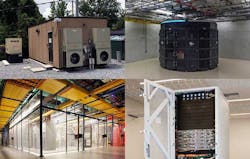The Business Edge Emerges: Deals Highlight Growing Investment in Edge Computing
Edge computing is cool and all. But who’s going to pay to build it, and use it? That’s been the big question facing the emerging edge data center industry, as we noted in our 2020 forecast in predicting that “the economics of edge computing will come into sharp relief in 2020.”
The good news: The Business Edge is here, as seen in a flurry of announcements last week that showcased the many ways stakeholders in distributed computing are stepping up their investment and deploying real-world edge infrastructure. After many months of studying the market, companies are coming off the sidelines and deciding how they want to deploy infrastructure, and with whom.
Last week’s announcements span a range of use cases – 5G wireless, the Internet of Things (IoT), artificial intelligence (AI) and interconnection – with beneficiaries across the spectrum of digital infrastructure. Here’s a recap:
- Vapor IO announced an agreement with Alef Edge to deploy a mobile edge computing platform in Atlanta and Pittsburgh, with plans to expand to as many as 36 sites as Vapor IO builds out its national network of modular edge data centers.
- Amazon Web Services said it will deploy three new AWS Wavelength Zones on the Verizon 5G Ultra Wideband network in Atlanta, New York City, and Washington DC. Wavelength embeds AWS compute and storage services in the telecom network, enabling developers to use 5G connections to create low-latency apps.
- Regional data center specialist Flexential teamed with American Tower to begin deploying edge computing infrastructure, with an initial deployment in Atlanta. The deal is the first in a planned series of local edge facilities to deploy Flexential’s FlexAnywhere network fabric and cloud on-ramp offering.
- Equinix announced that Nokia will deploy its Worldwide IoT Network Grid (WING) managed service in multiple Equinix data centers, providing faster market entry and expansion for operators deploying IoT business services.
These announcements confirm that edge deployment will arrive first in major cities rather than remote cell towers, but also may generate business to players across products and industry niches. Case in point: Three of partnerships feature new infrastructure in Atlanta, with deployments at towers, data center modules, regional data centers, cloud nodes and carrier hotels.
As always, the dueling definitions of edge computing have some wondering whether these are actual edge deployments – in effect, whether they are “edgy enough” to be actual edge. As we’ve noted, edge computing consists of many layers and locations, but the bottom line is that edge business is beginning to materialize across the spectrum. When you stack the definitions atop one another, they form a cumulative “edginess” that will mean more digital infrastructure in more places, and more people paying to build and use it.
Here’s a closer look at the latest announcements.
Vapor IO and AlefEdge
Vapor IO and AlefEdge will be rolling out their software-defined mobile edge (SD-ME) services on Vapor’s Kinetic Edge platform, nationwide. The Software Defined Mobile Edge allows enterprises to deploy edge computing on top of private wireless networks, creating a low-cost path to edge-enabled mobile applications, such as factory robotics, IoT, and other use cases that benefit from applications delivered at the edge of the network.
The combined platforms provide a way to deploy edge computing services onto private networks, including existing LTE, CBRS and Wi-Fi networks, as well as forthcoming 5G networks. The companies say the combination provides the architecture to support “near-prem” requirements that demand ultra-low latency and high bandwidth.
“A programmable mobile Edge has been out of reach for most of today’s enterprises because of the complexity of both deployment and application development,” said Ganesh Sundaram, CEO of AlefEdge. “Placing our service atop Vapor IO’s Kinetic Edge platform enables us to quickly deploy nationally and support ‘near prem’ workloads in the top 36 US Markets. Our services allow enterprises to leverage shared resources while maintaining the benefits of on-prem IT without the overhead of on-site management.”
The AlefEdge SD-ME platform and APIs make it easier for enterprises to implement remote work policies and edge-enabled applications through a programmable network layer.
In January of this year, Vapor IO announced its series C financing, raising a total of $90 million to build out its Kinetic Edge platform in 36 U.S. markets by the end of 2021. “Vapor IO has an aggressive rollout plan that spans the entire U.S.,” said Cole Crawford, CEO at Vapor IO. “Together with partners like AlefEdge we are building the next chapter of the Internet.”
AWS and Verizon
Amazon Web Services has big ambitions in edge computing, built atop AWS Outposts, which are racks filled with turn-key AWS cloud infrastructure. Outposts provide the hardware to run the Wavelength software. Verizon and other early-adopter telcos will deploy Outpost racks in their networks, and use them to offer cloud services to their customers. With Wavelengths, Amazon acts as the vendor to the telecom provider, who sells the services and owns the customer relationship.
The Bullish Case for the Future of Edge Computing
With the launches in Atlanta, New York City, and Washington, AWS now offers 5 Wavelength Zones on Verizon’s 5G network. Wavelength Zones were previously announced in Boston and San Francisco Bay Area.
The AWS-Verizon partnership brings the power of the world’s largest cloud closer to mobile and connected devices at the edge of the Verizon 5G Ultra Wideband network, reducing the hops and latency required to connect from a 5G device to an application hosted on AWS.
“Among the many ultra-low latency use cases that Wavelength enables are 5G applications that deliver interactive and immersive experiences, like game streaming, virtual reality, and in-venue experiences for live events,” Amazon said in its announcement. “Similarly, deploying latency-sensitive financial services applications to Wavelength Zones offer traders and financial market analysts near real-time analysis to help with risk profiles and portfolio strategies.”
The announcement included links to use cases from YBVR, Zixi, and CrowdVision that are using AWS Wavelength and Verizon 5G Edge to deliver enhanced experiences to their customers.
Flexential and American Tower
The first Flexential Local Edge will utilize American Tower’s Edge Data Center at 55 Marietta Street in the global telecom hub of Atlanta. Atlanta is one of three locations where Flexential will be using American Tower Edge Data Center infrastructure, with plans to expand in Denver and Boulder, Colorado.
Flexential Local Edge allows customers to deploy hardware and software very close to the end-user or application, and tap into Flexential’s portfolio of cloud solutions. The FlexAnywhere fabric uses a scalable 100Gbps backbone to provide access to Flexential’s data centers and cloud connectivity to public clouds AWS, Microsoft Azure and Google.
“By combining our strengths with these partners, we can leverage the FlexAnywhere network to offer our customers the means to drive edge computing even further than it has been – not just to the metro area but also to the street level,” said Flexential Chief Executive Officer Chris Downie. “This is an exciting advancement lowering latency to our customers in various industries, including transportation, logistics, finance, gaming and healthcare, supporting a variety of IoT, video, AI, and other real-time dynamic applications. Local Edge will push to use 5G and AI in a more meaningful way for traffic controls, autonomous vehicles, infrastructure monitoring and more. We see this an opportunity in many markets around the country to provide a true differentiator.”
Equinix and Nokia IOT
Special Report: Edge Computing and Why It Matters, in 2020 and Beyond
Nokia is leveraging Equinix IBX data centers to deploy both core and edge nodes to support mobile, IoT and cloud connectivity at global scale. Additionally, Nokia and Equinix are exploring edge architectures and deployment models that can improve the performance of use cases relating to cloud computing, artificial intelligence, machine learning and IoT.
“Nokia needed access to multiple markets and ecosystems to connect to NSPs and enterprises who want a play in the IoT space,” said Jim Poole, VP, Equinix. “By directly connecting to Nokia WING, mobile network operators can capture business value across IoT, AI and security, with a connectivity strategy to support business transformation.”
As localized data collection and analysis grows across cities and countries, customers will seek out lower latency infrastructures (like that provided by Equinix and Nokia) to connect and collect data from billions of IoT devices. With this solution, Nokia is helping mobile network operators extract valuable insights to evolve their business performance. Nokia is working with Equinix to roll out WING deployments quickly and efficiently for its customers across regions.
“Nokia WING offers a superior IoT service experience for operators through global network presence, unified orchestration and consistent service level agreements,” said Ankur Bhan, Head of WING, Nokia. “This deal will support our efforts to manage IoT-related data analysis on a global basis.”






